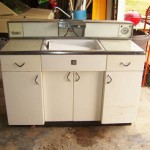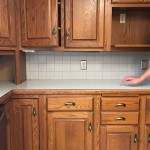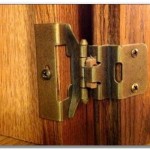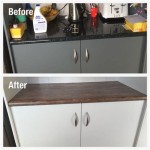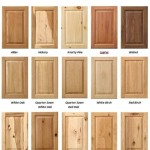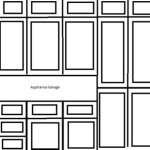Illuminating Your Kitchen: A Guide to Light Kitchen Cabinets
Kitchen cabinets are foundational elements in defining a kitchen's aesthetic and functional capacity. The selection of cabinet styles, materials, and finishes contributes significantly to the overall ambiance of the space. Among the various options available, light-colored kitchen cabinets have gained considerable popularity for their ability to create bright, spacious, and inviting kitchen environments. This article will explore the advantages, considerations, and stylistic applications of light kitchen cabinets, offering a comprehensive guide for homeowners and designers alike.
Light kitchen cabinets encompass a range of shades, from crisp whites and soft creams to pale grays and muted blues. These lighter hues reflect light more effectively than darker colors, which can be particularly advantageous in smaller kitchens or spaces with limited natural light. The visual effect is one of openness and airiness, making the kitchen feel larger and more welcoming. Beyond their aesthetic appeal, light cabinets also offer practical benefits in terms of maintenance and versatility, easily complementing a wide array of design styles.
The Advantages of Light Kitchen Cabinets
One of the primary benefits of light kitchen cabinets is their capacity to enhance the brightness of a kitchen. Light colors inherently reflect light, both natural and artificial, making the space feel more illuminated and vibrant. This can be especially beneficial in kitchens that lack ample sunlight or are located in the interior of a home. Brighter kitchens are not only more visually appealing but also safer and more functional, as they improve visibility for food preparation and other kitchen tasks.
Another advantage lies in their ability to create a sense of spaciousness. Darker cabinets can visually shrink a room, making it feel cramped and enclosed. Light cabinets, on the other hand, have the opposite effect, creating an illusion of greater size and openness. This is particularly valuable in smaller kitchens where maximizing the perceived space is a priority.
Furthermore, light-colored cabinets tend to show less dust and fingerprints compared to darker cabinets. While no cabinet material is entirely immune to dirt and grime, lighter surfaces often conceal minor imperfections more effectively, requiring less frequent cleaning. This can be a significant advantage for busy homeowners who want to maintain a clean and tidy kitchen without excessive effort.
Finally, light cabinets offer considerable flexibility in terms of design compatibility. They can be seamlessly integrated into a variety of kitchen styles, from traditional and classic to modern and contemporary. This versatility allows homeowners to adapt their kitchen décor and accessories without needing to replace the cabinets themselves, offering significant long-term value.
Material and Finish Options for Light Cabinets
The selection of materials and finishes for light kitchen cabinets is critical to achieving the desired aesthetic and ensuring durability. Several popular options are available, each with its own unique characteristics and price point.
Painted cabinets are a common choice for achieving a light and uniform color. Paint can be applied to various cabinet materials, including wood, MDF (medium-density fiberboard), and even laminate. Painted cabinets offer a wide range of color options and can be easily repainted in the future if desired. However, painted surfaces can be susceptible to chipping and scratching, requiring careful handling and maintenance.
Laminate cabinets are a cost-effective alternative to painted wood cabinets. Laminate is a synthetic material that is bonded to a core substrate, providing a durable and easy-to-clean surface. Light-colored laminates can mimic the appearance of painted wood cabinets, offering a budget-friendly option for achieving a similar aesthetic. While laminate is relatively durable, it is not as resistant to damage as solid wood or other high-end materials.
Wood cabinets with a light stain or a natural finish are another popular choice. Light-stained wood cabinets showcase the natural grain and texture of the wood, adding warmth and character to the kitchen. Common wood species used for light cabinets include maple, birch, and oak, all of which offer a range of grain patterns and visual appeal. A clear or lightly tinted sealant is typically applied to protect the wood and enhance its natural beauty.
Thermofoil cabinets are made by wrapping a layer of vinyl around an MDF core. This creates a seamless, durable surface that is resistant to moisture and staining. Thermofoil cabinets are available in a variety of light colors and patterns, offering a cost-effective option for achieving a clean and modern look. However, thermofoil can be susceptible to heat damage, so it is important to avoid placing them near heat sources such as ovens and stovetops.
High-gloss cabinets offer a sleek and contemporary aesthetic with a highly reflective surface. These cabinets are typically made from acrylic or laminate and are available in various light colors. High-gloss cabinets can create a dramatic effect in a kitchen, reflecting light and enhancing the sense of space. However, they can also be more prone to showing fingerprints and smudges, requiring more frequent cleaning.
Stylistic Considerations for Light Kitchen Cabinets
Light kitchen cabinets can be integrated into a wide range of kitchen styles, from traditional to contemporary. Understanding the nuances of each style and how light cabinets can complement them is essential for achieving a cohesive and visually appealing design.
In traditional kitchens, light cabinets can be paired with classic architectural details, such as raised-panel doors, intricate moldings, and decorative hardware. Soft whites, creams, and light grays are popular choices for traditional cabinets, creating a warm and inviting atmosphere. These cabinets can be complemented by granite countertops, hardwood floors, and traditional lighting fixtures.
Farmhouse kitchens often feature light cabinets with a rustic or distressed finish. Shaker-style cabinets in white or light gray are a common choice, paired with butcher block countertops, apron-front sinks, and open shelving. The overall effect is one of simplicity, functionality, and country charm. Light cabinets help to brighten the space and create a welcoming atmosphere.
Modern kitchens often feature sleek and minimalist light cabinets with clean lines and a focus on functionality. Slab-front cabinets in white, light gray, or light beige are a popular choice, paired with stainless steel appliances, quartz countertops, and minimalist hardware. The overall effect is one of sophistication, simplicity, and efficiency. Light cabinets help to create a bright and airy space that feels uncluttered and modern.
Contemporary kitchens offer a more eclectic mix of styles, often incorporating elements from both traditional and modern designs. Light cabinets can be paired with bold colors, unique textures, and unexpected accessories. For example, light gray cabinets can be combined with a colorful backsplash, statement lighting, and modern artwork. The overall effect is one of personality, creativity, and individual expression. Light cabinets provide a neutral backdrop that allows other design elements to stand out.
Scandinavian kitchens are characterized by their simplicity, functionality, and use of natural materials. Light cabinets in white or light wood tones are a common choice, paired with wood countertops, minimalist hardware, and natural textiles. The overall effect is one of tranquility, serenity, and a connection to nature. Light cabinets help to maximize the natural light and create a bright and airy space.
Coastal kitchens often feature light cabinets in shades of white, blue, or green, reflecting the colors of the ocean and sky. Shaker-style cabinets are a popular choice, paired with quartz countertops, glass tile backsplashes, and nautical-inspired accessories. The overall effect is one of relaxation, serenity, and a connection to the sea. Light cabinets help to create a bright and airy space that feels like a seaside retreat.
Ultimately, the choice of light kitchen cabinets depends on personal preferences, the overall design of the home, and the desired aesthetic. By carefully considering the advantages, materials, finishes, and stylistic options available, homeowners can create a kitchen that is both beautiful and functional.
Maintaining Light Kitchen Cabinets
Proper maintenance is essential for preserving the beauty and longevity of light kitchen cabinets. Regular cleaning and preventative measures can help to keep cabinets looking their best for years to come.
Regular cleaning is crucial for removing dust, dirt, and grime from cabinet surfaces. A soft cloth dampened with warm water and a mild detergent is typically sufficient for cleaning most light cabinet materials. Avoid using abrasive cleaners or scouring pads, as these can scratch or damage the finish. For stubborn stains, a mild solution of vinegar and water can be used.
Immediate attention should be given to spills and splatters. Wipe up spills as soon as possible to prevent staining or damage to the cabinet surface. Acidic or oily spills can be particularly damaging, so it is important to clean them up promptly. Use a clean, dry cloth to absorb the spill, and then clean the area with a mild detergent and water.
Protect cabinets from excessive heat and moisture. Avoid placing hot pots or pans directly on cabinet surfaces, as this can cause damage. Use trivets or heat-resistant mats to protect the cabinets from heat. Similarly, avoid exposing cabinets to excessive moisture, as this can cause warping or discoloration. Ensure that the kitchen is properly ventilated to reduce humidity levels.
Inspect cabinets regularly for signs of damage or wear. Check for chips, scratches, or cracks in the finish. If any damage is detected, repair it promptly to prevent further deterioration. Minor scratches can often be repaired with a touch-up paint or stain. More serious damage may require professional repair or replacement.
Hardware maintenance is also important for keeping cabinets in good working order. Tighten loose screws on hinges and handles regularly to prevent them from becoming damaged. Lubricate hinges with a silicone-based lubricant to keep them moving smoothly. Clean hardware periodically with a mild detergent and water to remove dirt and grime.
By following these maintenance tips, homeowners can ensure that their light kitchen cabinets remain beautiful and functional for many years to come. Regular cleaning, prompt attention to spills, protection from heat and moisture, and hardware maintenance are all essential for preserving the value and appearance of light kitchen cabinets.

How To Choose And Install Led Strip Lights For Kitchen Cabinets

Light Wood Finish Shaker Kitchen Diamond Cabinetry

What You Need To Know About Under Cabinet Lighting

9 Best In Cabinet Lighting Options And Ideas

Kitchen Cabinet Lighting Ideas For Your Home Design Cafe

Under Cabinet Kitchen Lighting Pictures Ideas From

Kitchen Cabinet Lighting Ideas For Your Home Design Cafe
Led Under Cabinet Lighting Projects How To Use Strip Lights

Light Color Kitchen Cabinets The Rta

Under Cabinet Lighting Adds Style And Function To Your Kitchen Decoist
Related Posts

